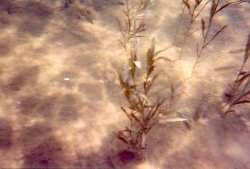>>> Do you not experience any problems with Hygrogen sulphide in your tanks?
No.
I am well aware that anærobics in an open system are in fact beneficial because the reducing conditions keep Iron in the ferrous Fe++ state, (green), which is more readily used by plant roots. In oxidising conditions, (ærobic), the Iron looses a further electron and becomes the practically inert ferric Fe+++ ion, (orange-red).
In closed systems, anærobic build ups in the presence of sulphur compounds will allow bacterial chemosynthesis resulting in HS. This is most undesirable in the house, although I suspect small quantities at least, are of no real consequence in the tank.
The action of MTS, plant roots and my chop stick, coupled with the very even grain size and shape of the pool filter sand does not allow it to pack and produce deeply anærobic pockets. I strive to keep the substrate on the edge of anærobic.
When collecting, (SE Asia, Congo Basin, Amazon Basin), the substrate in all but a few cases has been a very fine mud which stirs up into a cloud if you uproot a plant. It is black, full of slowly decaying organics, (leaf litter etc.), and stinks to high heaven, part of the odorous cocktail is HS, but there are other decay products in there as well. The lack of O2 in the soil means the decay rate is slow, so the organics take a while to totally reduce to fine material.
The only place I ever found substantial numbers of plants growing in anything resembling gravel was in the Canima region in the extreme south of Venezuela, near the border with Brazil. There are shallow fast flowing rivers and falls, not rapids as such. Here the current had removed the small silty stuff and left a passable imitation of aquarium gravel. There was an odd plant growing there. Brown and leathery. It looked for all intent and purpose like Fucus serratus or some similar seaweed, but I was 1000km+ from the sea, the water was tea brown with tanins, had a pH of 5.6 no measurable hardness 27C and open to the full tropical sun 12 hours a day. Never did find out what it was.
I did find plants growing in Lake Malawi in sand, but they were few and far between, Potamogeton schweinfurthii, the spotted cichlids in the pic are Fossorochromis rostratus.



